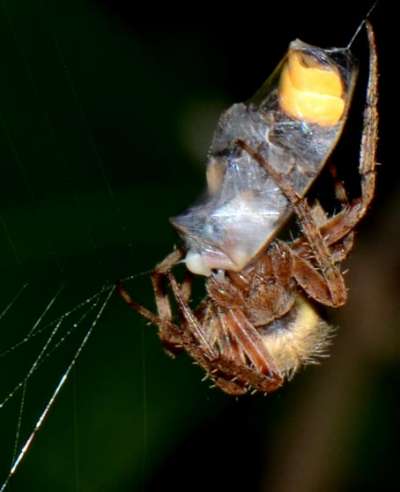
As daylight drains from the summer sky, a cool breeze rustles through a hay-scented New England meadow. Relaxing in the long grass, even the keenest observer might miss the miniature army that’s now awakening from its daytime slumber. One by one, tiny male fireflies are creeping upward along grass highways. They pause at each apex, ready to lift off like silent Black Hawks. But as they prepare for their nightly search missions, these firefly males aren’t motivated by military conquest. Their quest? Genetic immortality. They’re hell-bent on procreation, driven by an urgent need to propel their genes into the next firefly generation. These resolute males are destined to spend every night of their short adult lives valiantly broadcasting their luminous signals. Unfortunately, the odds are stacked against them as they head off into the night looking for love.
These are Photinus fireflies, the most common lightning bugs in North America. We happen to know about Photinus sex lives in intimate detail – more than we know about any other firefly in the world. This deep knowledge is mainly due to Jim Lloyd, a professor emeritus at the University of Florida who grew up near the Mohawk Valley in New York State and went to school at Cornell University in the mid-1960s. Like most college students, Lloyd was fond of road trips, spending summers crisscrossing the United States in his pickup. Unlike other students, he did much of his traveling at night, driving backroads with his headlights off, head stuck out the window looking for firefly flashes.
As a doctoral student, Lloyd discovered that males of each Photinus species emit a different pattern of flashes. Depending on what species he belongs to, a Photinus male will court by emitting a flash pattern with one, two, or several pulses of light. After a short pause, he repeats the whole pattern again. Each flash pattern is distinctive in how many light pulses it contains, how long each pulse lasts, and the dark interval between pulses.
So it’s the timing of a male’s flash, rather than its color or shape, which conveys the crucial information about his species identity and sex. Like mariners who use the distinctive light pattern to tell which lighthouse they’re approaching, female fireflies use such differences in flash timing to distinguish the males of their own species.
Heading Out Into the Night
The fireflies in our New England meadow are a species known as Photinus greeni, whose males give a distinctive pair of quick light pulses separated by 1.2 seconds. Poised atop grass blades, our army of firefly males has waited patiently for darkness. Now each male lifts off into the air to start his nightly patrol. As he flies, he earnestly advertises his availability about every four seconds by flashing out to anyone who’s watching: “I’m a greeni male, here I am! I’m a greeni male, here I am!” Each time he shines his light, the male pauses for an instant in hopes of spotting a female. So tonight across the meadow, it’s wink, wink, hover and hope . . . wink, wink, hover and hope . . . wink, wink, hover and hope. Males concentrate their efforts in places where females are likely to gather and then fly along to the next likely pickup spot. Hundreds of flying males now fill the meadow, their flashes scintillating like sunlight glinting off the sea.
What’s a firefly’s worst nightmare? Sometimes I think it must be the sudden rainstorm that hits just when they’re starting their courtship flights. One night I watched as raindrops slammed into their tiny bodies, driving them down to earth like sodden shooting stars. Wet wings meant no more flying that night. These soggy males were forced to continue their courtship on foot, flashing sporadically as they plodded tediously through the grass in their search for females.
But where are those obscure objects of their desire, the females? Even though female Photinus greeni can fly, they rarely waste their precious energy doing so. Instead, they perch quietly on grass blades, like women perching on barstools at a singles bar. If a female spots an especially attractive male, she might deign to acknowledge his advances: she’ll flash him a come-hither reply, aiming her lantern in his direction. Photinus females usually give a single prolonged flash that rises in a crescendo and then slowly fades out. Here again, timing is everything. Across different Photinus species, females differ in how long they wait before flashing out their response. And males use these different response delays to identify females belonging to their own species. In Photinus greeni, females have a very short response delay: after the male flashes, they wait less than a second before offering their crescendo response.
A Light Snack
While our firefly male is flying and flashing, his mind set on sex, other nocturnal creatures are out here, too – and they’re intent upon dinner. This meadow is home to hundreds of wolf spiders and their orb-weaving cousins, all eager to put firefly filet on tonight’s menu. They’ve strung webs between the tallest grass stalks, invisible traps waiting to ensnare careless flyers. Lots of unlucky male fireflies will get quietly filtered out of the air tonight, and so will meet their sticky ends wrapped up tightly and hanging limply (see photo at left). Yet even as he dies, the unfortunate male’s flash may live on. Our field notebooks are filled with observations of fireflies shrouded in spider’s silk that continue their rhythmic flashing long after they’ve been immobilized. Their flashing attracts other fireflies, and sometimes these newcomers wind up trapped in the web too. Perhaps these spiders have figured out how to turn their captives into bioluminescent fishing lures.
What are the odds in this gamble between sex and death? Jim Lloyd decided to find out. He headed out from Gainesville, Florida, to a grassland hotspot for Photinus collustrans fireflies. Equipped with his sharp eyes, a surveyor’s wheel, and a tally counter, Lloyd spent several nights doggedly tracking 199 males – one at a time – as they cumulatively logged more than 10 frequent flyer miles and gave nearly 8,000 flashes. Only two males wound up finding females, while the same number found themselves in a predator’s deadly embrace. For a Photinus male, the search for mates is certainly a high-stakes game of reproductive roulette.
Closer Encounters
Back in our New England meadow, our male fireflies are still aloft. They’ve been patiently searching for nearly 20 minutes. Now, at last, one male glimpses a flashed reply from below. The time delay is just right for his species – finally, a female has answered his calls! He swiftly drops from the air to land nearby. A flirtatious flash exchange strikes up as he scrambles toward the female on foot. He runs partway up a grass blade, stops, and flashes. Will she answer him this time? No. He runs farther up the blade, stops, and flashes once more. Now she does reply, but rats – it looks like he’s been traveling in the wrong direction. He’ll need to retrace his steps. This intermittent courtship dialogue continues while the male runs frenetically up and down grass blades searching for the female. Another hour passes before he sees her response directly above him – she’s right here on the same grass blade! Rushing upward, he climbs onto her back. Mating begins without delay as he couples his genitalia with hers. But before this relationship can be consummated, he’ll need to swivel around to face in the opposite direction. Precariously perched on a narrow grass blade, the male needs considerable acrobatic skill to pull off this feat without tumbling to the ground. Once the pair has settled comfortably into a tail-to-tail position, their flashing ceases.
But wait...what happens after the lights go out? When I first began researching fireflies in the 1980s, most studies had focused on the flashier side of firefly courtship. Once the actual mating began, most sane scientists had packed up their field gear and headed home to their cozy beds. But I was fascinated by firefly sex lives. How long did firefly pairs remain coupled? Were these only brief flings? Were fireflies speed daters, breaking up only to take another mating partner later that night?
To answer these questions, my students and I have spent many sleepless and mosquito-filled nights tracking Photinus fireflies in fields around Boston. Each night we arrived at the study site promptly by 8:35 p.m., our clipboards ready and our headlamps equipped with blue filters – fireflies don’t see blue very well. When the male flight period started at nine, we dashed about to find as many responsive females as we possibly could. After flagging the location of each female’s perch, we marked her with a tiny dot of nontoxic paint. Then we sat down on our campstools to watch as each of our females started up dialogues with passing males. And we waited. And waited – sometimes firefly courtship conversations go on for hours.
When a pair finally made contact, we recorded what time the copulation began. Then we started making our rounds. All night long, every half hour, we checked to see whether each pair was still mating. When the sky lightened and the birds’ dawn chorus started up, we were still dutifully scribbling “mating in progress” onto our data sheets. Not until dawn did these firefly duos uncouple, clambering down their matrimonial grass blades to go their separate ways. In spite of our sleep deprivation, we were excited to have discovered that Photinus fireflies mate only once each night. Their protracted liaison is what scientists call “copulatory mate guarding,” a behavior male fireflies use to guard against females running off and hooking up with some rival later that night.
To the Victors Go the Spoils
It’s all very romantic, yet can our firefly love story really be so simple? No, it can’t.
I still recall the sweltering summer evening when I stumbled upon one startling firefly fact that changed the way I viewed firefly courtship and copulation. I was sitting on my back porch in Durham, North Carolina, with my dog, a black lab named Orpheus. We were both enjoying the clouds of fireflies that rose up from the grass when I began to wonder whether males and females were equally represented within this horde. I grabbed my insect net (biology graduate students generally keep such things handy), jumped off the porch, and started sweeping up all the flying creatures I could gather. In short order I’d netted several hundred fireflies that I released into some large plastic jugs. Over the next few hours, I gently extracted them one by one, examining their lantern shape to tell whether I held a male or a female in my hand. I was astounded when I realized I’d inspected over 200 fireflies, but I had yet to see a single female.
A trip to the university library convinced me that I would need to search down in the grass to find these Photinus females, so that’s what I did for the next few evenings. Orpheus, descended from a long line of hunting champions, became my first field assistant. We stayed up long past midnight, locating females by their response flashes. Each time I spotted one, I marked her location with a plastic survey flag. Once Orpheus figured out what I was doing, he put his pointing skills to good use. Looking over, I’d see him standing – his nose outstretched, paw up – telling me that he’d found another female firefly. When I counted up these flags, I was astonished to find we’d flagged only 12 females. This dating scene for male fireflies was ridiculously competitive: 218 males flashing their hearts out to only 12 females! During those few nights I gained a lasting respect for the long reproductive odds that male fireflies play against.
It turns out that the male-biased sex ratios that so startled me in my North Carolina backyard show up again and again in insects. Male mate competition has led to the evolution of many extraordinary mating behaviors. For one thing, males often get a jump-start on metamorphosis, and turn into adults sooner than the females. This pattern of early male emergence is known as protandry, and it’s common among butterflies, mayflies, mosquitoes, and fireflies. Male competition even compels some insect males to take child brides. In certain mosquitoes, spiders, and butterflies, males will jealously stand guard over an immature female, chasing off rival males and waiting patiently until she becomes sexually mature. Males of some tropical Heliconius butterflies will guard an immature female pupa for days, pushing their genitalia right through the cocoon so they can copulate just as soon as the female emerges. Some male fireflies also use this child-bride tactic, guarding immature females and then mating when the female crawls out.
Mate competition isn’t just about being the first one to reach the female. The classic animated film Bambi features a highly charged scene in which two adolescent male deer lock antlers over their common sweetheart. In many beetles, reptiles, and mammals, males have evolved horns, antlers, tusks, and spurs that they wield in fierce battles against rival males. In fireflies, though, such male-male interactions are a lot subtler. Males that are lucky enough to spot a female and engage her in a flash dialogue rarely have a chance to talk privately. Like a magnet, flash dialogues quickly attract other males. Very soon, each female finds herself surrounded by a small coterie of suitors, all flash-competing to capture her attention.
If you were to set up a campstool and spend some time carefully watching these competitive courtships, you might get to see some especially sneaky male behavior. When several males are all courting a single female, sometimes one male will slyly give a pseudo-female flash in response to a rival male. Looking just like a female flash, the male’s pseudo-female flash crescendos, then slowly fades out; he also flashes using the female’s typical response delay. Based on my own experience trying to locate females, I know these transsexual flashes can be pretty convincing. It appears these males have figured out a clever way to decoy competitors away from the real females.
Even though they lack overt weaponry, competition among male fireflies sometimes gets physical. In Photinus pyralis, the Big Dipper firefly, sometimes as many as 20 rival males will surround a single female, creating a writhing love knot. Males vigorously push and shove each other, using their head shields to dislodge their rivals. Eventually one male wins out and mates with the female, although what exactly makes a male victorious in these battles isn’t yet known. Poor losers or ever hopeful, several of the losing males often pile on top of the happy couple, stacking themselves up to six deep. Perhaps this is why male Pteroptyx (“bent-winged”) fireflies from southeast Asia use their wing covers to tightly clamp around their mate’s abdomen – it seems a good way to prevent hostile takeovers.
Seen through the lens of sexual selection, we now have an entirely different view of the lovely luminous display out here in this meadow. It stars hundreds of male fireflies flying and flashing their hearts out in a quest for genetic survival. Male fireflies spend night after night flash-competing with scores of rivals to locate scarce females. These nocturnal flights require a lot of energy and are fueled only by whatever the male has managed to store up during his larval feasting. And as we’ve seen, flight isn’t the only courtship expense incurred by males; their search missions are also fraught with dangerous predators. In fireflies, courtship is definitely a big-ticket affair, and the cost rests squarely on the males’ shoulders.






Discussion *